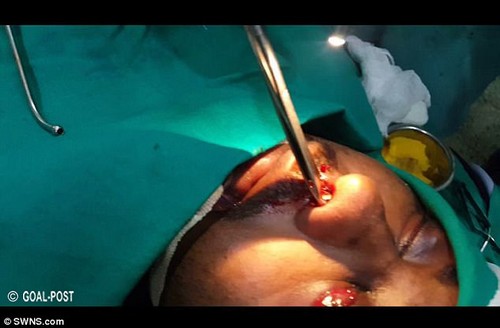From August 2, 2016, to December 11, 2017, we recruited patients on general wards at the University Hospital in Bern, Switzerland, and at Addenbrooke’s Hospital in Cambridge, United Kingdom.
Patients
Inclusion criteria included an age of 18 years or older and inpatient hyperglycemia requiring subcutaneous insulin therapy.
Exclusion criteria were type 1 diabetes, pregnancy or breast-feeding, and any physical or psychological disease or the use of medication that was likely to interfere with the conduct of the trial or the interpretation of the results. Inpatients were identified through hospital electronic records. All the patients provided written informed consent before the initiation of trial procedures.
Trial Design
We randomly assigned the patients to receive insulin by means of a fully automated, closed-loop system (closed-loop group) or conventional subcutaneous therapy (control group). Patients were followed for a maximum of 15 days or until hospital discharge. Randomization was performed by means of the minimization method with the use of Minim randomization software,22 which is a biased-coin approach with a probability of 0.7 to 0.8 for allocation of the “best fitting” treatment.
Randomization was stratified according to glycated hemoglobin level, body-mass index (the weight in kilograms divided by the square of the height in meters), and pretrial total daily insulin dose to balance the two groups. Investigators who analyzed the trial data were aware of the trial-group assignments.

Trial Procedures
The body weight, height, and total daily insulin dose were recorded for each patient after enrollment. Throughout the trial, the patients chose standard hospital meals at usual mealtimes, according to local practice. The patients were free to consume other meals and snacks and were unrestricted in their usual activity on the general ward. In the two groups, glucose levels were measured with the use of a continuous glucose monitor (Freestyle Navigator II, Abbott Diabetes Care).
A glucose sensor was inserted subcutaneously into the abdomen or upper arm by the investigator and calibrated according to the manufacturer’s instructions. Point-of-care capillary glucose measurements (StatStrip Glucose Hospital Meter System, Nova Biomedical, or Accu-Chek Inform II, Roche Diagnostics) were performed by nursing staff members according to local clinical practice in the two trial groups.
Closed-Loop Insulin Delivery
Investigators discontinued each patient’s usual insulin therapy and sulfonylurea medication, if prescribed, on the day of closed-loop initiation. All other medications were continued. The investigator inserted a subcutaneous cannula into the abdomen for delivery of a rapid-acting insulin analogue (Humalog, Eli Lilly, or NovoRapid, Novo Nordisk) by means of a trial pump (Dana Diabecare R, Sooil). The investigator initialized the control algorithm by using the patient’s weight and pretrial total daily insulin dose. When sensor readings became available, the investigator initiated automated closed-loop glucose control, which continued for up to 15 days. A low-glucose sensor alarm on the continuous glucose-monitoring receiver was initialized at a threshold of 63 mg per deciliter (3.5 mmol per liter).
The automated closed-loop system consisted of a model predictive control algorithm (version 0.3.70) residing on a control algorithm device (Dell Latitude 10 Tablet, Dell) linked by a USB cable to the continuous glucose-monitoring receiver (Fig. S1 in the Supplementary Appendix, available with the full text of this article at NEJM.org). The tablet device communicated with the pump by means of a Bluetooth wireless communication protocol. No prandial insulin boluses were delivered, and the timing or carbohydrate content of meals was not included in the control algorithm. (Additional details regarding the closed-loop system are provided in the Supplementary Appendix.)
At the end of the closed-loop period, patients completed a brief questionnaire to evaluate their satisfaction and trust of automated glucose control with the closed-loop system, their acceptance of wearing trial devices, and their views as to whether they would recommend the technology to other patients. Conventional insulin therapy and sulfonylurea medication were resumed at the end of closed-loop use as appropriate.
Conventional Insulin Therapy
For each patient, the usual insulin and other antihyperglycemic therapies were continued throughout the trial period. To reflect usual care, the continuous glucose monitor was masked to the patient, investigators, and hospital staff members. Each patient’s glucose control was managed by the clinical team, according to local clinical practice on the basis of capillary glucose measurements. The clinical team was allowed to modify and adjust each patient’s insulin and other antihyperglycemic therapies and to initiate additional point-of-care capillary glucose measurements as appropriate.
Trial Oversight
The protocol (available at NEJM.org) was approved by the local research ethics committee at each center and by regulatory authorities in Switzerland (Swissmedic) and in the United Kingdom (Medicines and Healthcare Products Regulatory Agency). The safety aspects of the trial were overseen by an independent data and safety monitoring board. The trial was performed in accordance with the principles of the Declaration of Helsinki.
Abbott Diabetes Care supplied discounted continuous glucose-monitoring devices, sensors, and details regarding the communication protocol to facilitate real-time connectivity; company representatives reviewed the manuscript before submission but otherwise had no role in the trial conduct. All the authors participated in the design of the trial or provided patient care and obtained samples. The first, second, and last author wrote the first draft of the manuscript. The last author designed and implemented the control algorithm, and all the authors critically reviewed the manuscript. The first and last authors vouch for the completeness and accuracy of the data and analyses and for the adherence of the trial to the protocol. All the authors made the decision to submit the manuscript for publication.
Primary and Secondary Outcomes
The primary outcome was the percentage of time that the sensor glucose measurement was in the target glucose range of 100 to 180 mg per deciliter (5.6 to 10.0 mmol per liter) for up to 15 days or until hospital discharge. Secondary outcomes were the percentage of time that the sensor glucose measurement was either above or below the target range; the percentage of time spent above 360 mg per deciliter (20.0 mmol per liter), below 70 mg per deciliter (3.9 mmol per liter), below 54 mg per deciliter (3.0 mmol per liter), and below 50 mg per deciliter (2.8 mmol per liter); the area under the curve below 63 mg per deciliter (3.5 mmol per liter) and below 54 mg per deciliter; the mean daily sensor glucose measurement; and the total daily insulin dose.
We used data collected throughout the trial period to evaluate glucose variability according to the standard deviation and the coefficient of variation in the sensor glucose measurement. We calculated the between-day coefficient of variation in the sensor glucose measurement from daily mean glucose values (midnight to midnight). Additional secondary outcomes and exploratory analyses are described in the Supplementary Appendix.
Safety end points included clinically significant hyperglycemia (>360 mg per deciliter) with ketonemia and severe hypoglycemia (<40 mg per deciliter), as determined by point-of-care capillary measurements, along with other adverse events and serious adverse events.
Statistical Analysis
The trial was designed to have a power of 80% to detect a clinically significant between-group difference in the primary outcome of 20 percentage points with the use of a two-sided t-test and an alpha level of 0.05. To reflect heterogeneity among the patients, a standard deviation of ±39 for the primary outcome was used for the power calculations. We planned that 150 patients would undergo randomization in order to permit the analysis of at least 48 hours of data from 120 patients.
The intention-to-treat analysis was performed on data collected during subcutaneous insulin delivery. Data from patients who participated in a separate feasibility study21 were not included in the present analysis. Outcomes were calculated with the use of GStat software, version 2.2 (University of Cambridge), and statistical analyses were performed with the use of SPSS software, version 21.0 (IBM).
We used the unpaired t-test to compare normally distributed variables and the Mann–Whitney U test for highly skewed variables. The numbers of events that were related to a capillary glucose measurement of less than 63 mg per deciliter and 40 mg per deciliter and more than 360 mg per deciliter were tabulated in each trial group and compared with the use of Fisher’s exact test. Values are reported as means (±SD) or medians (interquartile range), unless stated otherwise. All P values are two-tailed, and P values of less than 0.05 were considered to indicate statistical significance.



